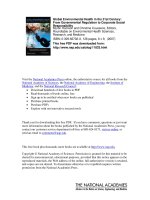Psychology applied to modern life adjustment in the 21st century, 11e chapter 6
Bạn đang xem bản rút gọn của tài liệu. Xem và tải ngay bản đầy đủ của tài liệu tại đây (893.79 KB, 49 trang )
Chapter 6
The Self
Self-Concept, continued
•
The nature of the self-concept
–
–
Self-concept – “an organized collection of beliefs about the self”.
These beliefs are also called self-schemas and include personality traits,
abilities, physical features, values, goals, & social roles (see Figure 6.1).
–
Possible selves – refer to “one’s conceptions about the kind of person
one might become in the future”.
Figure 6.1. The self-concept and self-schemas. The self-concept is composed of various selfschemas, or beliefs about the self. Jason and Chris have different self-concepts, in part, because they
have different self-schemas.
Self-Discrepancies
•
Individuals have the following self-perceptions:
–
–
–
An actual self (qualities people think they actually possess).
An ideal self (qualities people would like to have).
An ought self (qualities people think they should possess).
Self-Discrepancies, continued
•
Self-discrepancies –mismatches between the actual, ideal, and/or ought
selves.
•
These can cause various effects: Figure 6.2.
–
When the “actual self” falls short of the “ideal self”, we feel dejected and
sad.
–
When the “actual self” falls short of the “ought self”, we feel irritable and
guilty.
Figure 6.2. Types of self-discrepancies, their effects on emotional states, and possible consequences. According to E. Tory Higgins (1989), discrepancies between actual and
ideal selves produce disappointment and sadness, whereas discrepancies between actual and ought selves result in irritability and guilt. Such self-discrepancies can make individuals
vulnerable to more serious psychological problems, such as depression and anxiety-related disorders.
Self-Discrepancies, continued
•
People cope with self-discrepancies by
–
–
Changing their behavior to bring it more in line with the ideal, or ought, self.
Blunting self-awareness by
•
•
Avoiding situations that increase self-awareness, or
By using alcohol (see Figure 6.3).
Figure 6.3. Self-awareness and alcohol consumption. Individuals who were high in self-awareness drank significantly more wine in a 15-minute period if they believed that they had
performed poorly on an IQ test than did any other group. This finding shows how people sometimes try to blunt self-awareness to cope with self-discrepancies.
From Hull, J.G., & Young, R.D. (1983). Self-Consciousness, self-esteem, and success-failure as determinants of alcohol consumption in male social drinkers. Journal of
Personality and Social Psychology, 44, 1097-1109. Copyright © 1983 American Psychological Association. Reprinted by permission of the author.
Factors Shaping the Self-Concept
•
Festinger’s (1954) social comparison theory states that we compare
ourselves with others in order to assess and/or improve our abilities.
•
A reference group is “a set of people who are used as a gauge in making
social comparisons”.
–
If we want to improve, we choose reference groups of superior quality,
but
–
If we want to bolster self-esteem, we choose inferior groups.
Factors Shaping the Self-Concept, continued
•
•
Generally, our self-perceptions are distorted in a positive direction.
Feedback from others is important in balancing our own observations.
–
–
–
Early in life, parents and family members are the primary influences.
As children age, peers become progressively more important.
Later in life, close friends and marriage partners play dominant roles.
Factors Shaping the Self-Concept, continued
•
Social context also affect our self-concept.
–
We may view ourselves more, or less, critically, depending on the
situation.
Factors Shaping the Self-Concept, continued
•
Cultural values and self-concept
–
In cultures that value individualism – “putting personal goals ahead of
group goals” – identity is defined more in terms of personal attributes.
–
In cultures that value collectivism – “putting group goals ahead of
personal goals” – identity is defined more in terms of the groups one
belongs to.
Factors Shaping the Self-Concept, continued
Individualism vs. collectivism, continued
–
People raised in individualistic cultures
•
•
–
Have an independent view of the self.
View themselves as unique, self-contained, and distinct from others.
People raised in collectivist cultures
•
•
Have an interdependent view of the self.
View themselves as more connected to others (see Figure 6.5).
Figure 6.5. Independent and interdependent views of the self. (a) Individuals in cultures that support an independent view perceive the self as clearly separated from significant
others. (b) Individuals in cultures that support an interdependent view perceive the self as inextricably connected to others.
Adapted from Markus, H.R., & Kitayama, S. (1991). Culture and the self: Implications for cognition, emotion, and motivations. Psychological Review, 98, 224-253.
Self-Esteem, continued
•
•
•
Self-esteem refers “to one’s overall assessment of one’s worth as a person”.
It is a global evaluation of many aspects of the self (see Figure 6.6).
Self-esteem can be construed two ways:
–
–
Trait self-esteem (an enduring sense of confidence in a person).
State self-esteem (dynamic feelings about the self that change with the
situation).
Figure 6.6. The structure of self-esteem. Self-esteem is a global evaluation that combines assessments of various aspects of one’s self-concept, each of which is built up from many
specific behaviors and experiences. (Adapted from Shavelson, Hubner, & Stanton, 1976).
Self-Esteem, continued
•
Self-esteem and adjustment
–
–
Self-esteem is strongly and consistently connected to happiness.
People with high self-esteem also feel more likeable and attractive, have
better relationships, and make better impressions on others.
Self-Esteem, continued
Self-esteem and adjustment, continued
–
People with high self-esteem persist longer in the face of failure and cope
better with setbacks.
–
Self-esteem has not been linked to achievement, however.
Self-Esteem, continued
•
High self-esteem versus narcissism
–
–
Feeling too good about oneself is not desirable.
Narcissism – “the tendency to regard oneself as grandiosely selfimportant” - is pathological and different from high self-esteem, a healthy
trait.
Self-Esteem, continued
High self-esteem versus narcissism, continued
–
Narcissistic individuals
•
•
•
Are preoccupied with fantasies of success.
Believe they deserve special treatment.
React aggressively when their view of themselves (ego) is threatened
(see Figure 6.9).
Figure 6.9. The path from narcissism to aggression. Individuals who score high on narcissism perceive negative evaluations by others to be extremely threatening. This experience
of ego threat triggers strong hostile feelings and aggressive behavior toward the evaluator in retaliation for the perceived criticism. Low scorers are less likely to perceive negative
evaluations as threatening and, therefore, behave much less aggressively toward evaluators (Adapted from Bushman & Baumeister, 1998).
The Development of Self-Esteem
•
•
•
•
Parents play an important role in shaping self-esteem early in life.
Two dimensions of parenting are important
1. Parental acceptance.
2. Parental control.
Together, these dimensions yield four parenting styles (see Figure 6.11).
The authoritative style is associated with the highest self-esteem scores.
Figure 6.11. Baumrind’s four parenting styles. Four parenting styles result from the interactions of parental acceptance and parental control, as theorized by Diana Baumrind.
Adapted from Baumrind, D. (1971). Current patterns of parental authority [Monograph]. Developmental Psychology, 4(1, Part 2), 1-103. American Psychological
Association. Adapted by permission of the author.
The Development of Self-Esteem, continued
•
Teachers, classmates, and close friends also influence children’s self-esteem.
–
Children with perceived support from significant others have the highest selfesteem.
•
Children also use reference groups as a basis for self-judgments.
–
Those who feel competent, relative to others, have the highest self-esteem.
Ethnicity, Gender, and Self-Esteem
•
Ethnicity and gender interact in complex ways with regard to self-esteem:
–
White males have higher self-esteem than do white females, but minority
males have lower self-esteem than do minority females.
–
Overall, males score slightly higher on self-esteem than do females, and
white females have lower self-esteem than do minority females.
–
Individualism is also associated with high self-esteem.









